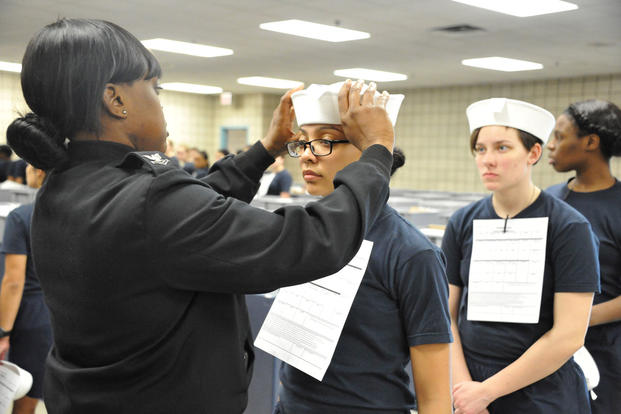The Navy is moving away from a uniform policy requiring unisex looks after some complained about fit, rank placement and other issues, a top admiral said Tuesday.
Male and female sailors have been wearing similar-looking uniforms since then-Navy Secretary Ray Mabus ordered the sea services to develop unisex items in 2015. The policy was driven by Mabus' thought that when someone sees a sailor or Marine, they should not be able to immediately tell whether they're a man or a woman based on the cut of their uniforms.
But Navy leaders say they're getting feedback from sailors who say the unisex looks "might not have been a good policy move or the right way to go," Fleet Master Chief Wes Koshoffer with Manpower, Personnel, Training and Education said during a Facebook live town hall event.
"So we're no longer pursuing any specific unisex uniform policy," he said. "Our strategy here is, in my words, we owe you a uniform that fits well, that wears well, that's appropriate to the environment that you're working in, with the best materials available at some cost that's affordable and makes sense -- uniforms that will last and that you're proud to wear."
Related: Beards Ashore: Navy's Personnel Boss Says He's Open to Considering Them
Some unisex uniform policies have had unintended awkward consequences. During the town hall event hosted by the chief of naval personnel, one sailor wrote in to ask if the enlisted rank insignia on sailors' working uniforms, which is placed in the center of the chest, could be moved.
"I am uncomfortable staring at a female's chest to see her rank," the sailor wrote. "It's hard to identify even from just a few feet away. ... Why can't we go back to ranks on eight-point covers or somewhere different on the uniform blouse?"
Koshoffer said he has gotten an "earful of feedback" from sailors on that topic. The Navy removed rank insignias from the covers and replaced it with an anchor, constitution and eagle to align with the Marine Corps' working uniform, which features the eagle, globe and anchor.
But leaders are considering changing the color of the rank insignia to make it easier to spot, or adding it to the collar or another position on the uniform, Koshoffer said.
"We're not ready to immediately reverse and go back to the rank on the hat, but we hear you about the uncomfortable gaze and we hear you on the visibility issue," he said.
Chief of Naval Personnel Vice Adm. John Nowell said the Navy wants to be sure it's getting sailors' feedback on possible uniform changes. When the service retired the female bucket cover, for example, some felt left out of the conversation.
One officer wrote about that lack of input on retiring the traditional cap and the push toward more masculine-style uniforms in a piece for Proceedings magazine titled "Nobody Asked Me, But ... Goodbye Bucket Cover."
Nowell said he wants to be sure no one is surprised by new uniform changes service leaders are considering.
"I think that's what kind of got a lot of folks a little bit up in arms," he said. "And I understand that where all of a sudden they said, 'Wait a minute, you're taking our bucket covers away? How did that happen?'"
Koshoffer said they'll continue assessing each Navy uniform item in the sea bag. Sailors can share their feedback about possible changes by participating in a bimonthly uniform focus group that reports directly to Nowell and the director of plans and policies.
-- Gina Harkins can be reached at gina.harkins@military.com. Follow her on Twitter @ginaaharkins.
Read More: New Data Shows Performance Divide on Army Combat Fitness Test














